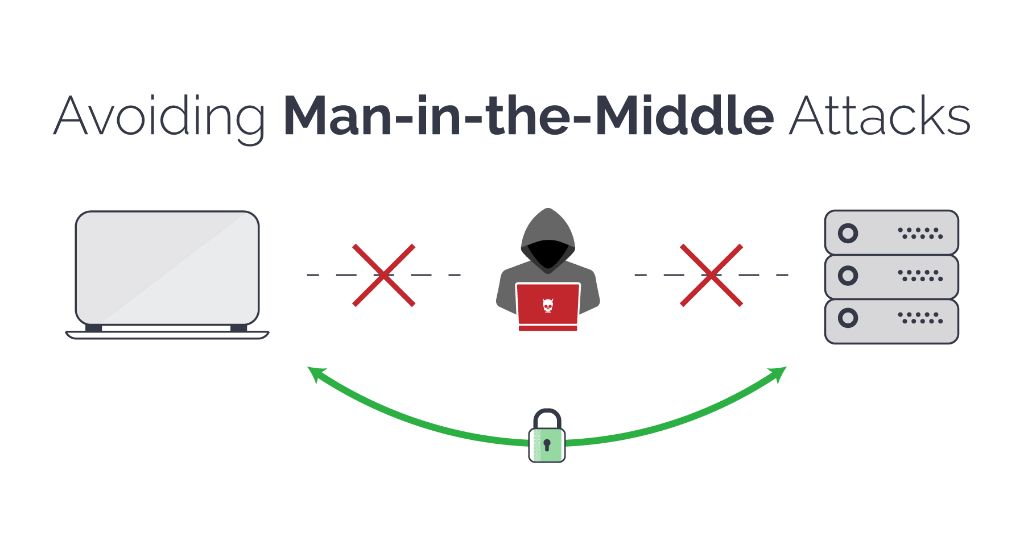A man-in-the-middle (MITM) attack is a cyber threat where a malicious actor inserts themselves into a conversation between two parties. The attacker is able to monitor and control the conversation, without the other participants knowing. This allows the attacker to steal information and manipulate the conversation. Preventing MITM attacks is crucial for protecting sensitive communications and data. There are several key strategies to prevent MITM attacks.
Use encryption
Encryption is one of the most important defenses against MITM attacks. Encryption scrambles data using cryptographic algorithms. Even if an attacker can intercept an encrypted message, they cannot decipher the contents without the encryption key. Some common encryption protocols that help prevent MITM attacks include:
- SSL/TLS – Secure Sockets Layer and Transport Layer Security encrypt communications between web browsers and servers. Sites should use TLS 1.2 or higher.
- VPN – Virtual Private Networks encrypt traffic between networked devices across public networks like the internet.
- SSH – Secure Shell encrypts traffic in network administration protocols like remote command line access.
- PGP/GPG – Pretty Good Privacy and GNU Privacy Guard provide end-to-end encryption for email.
Proper implementation and key management are crucial for encryption to fully prevent MITM attacks. However, robust encryption protects the confidentiality and integrity of communications even if traffic is intercepted.
Use authentication
Authentication verifies the identities of the communicating parties. This prevents attackers from impersonating legitimate users or entities. Strong authentication makes MITM attacks more difficult in several ways:
- Prevents interception of login credentials – Secure password policies and multi-factor authentication prevent attackers from stealing login information to impersonate users.
- Confirms identities – Digital certificates, signed cryptographic keys, and biometrics authenticate the identities of parties before communications begin.
- Detects tampering – Hashed message authentication codes and digital signatures validate information integrity and whether messages have been modified in transit.
Authentication ensures participants are who they claim to be and that information has not been altered. This provides assurance against tampering even if encryption keys are compromised.
Monitor certificate authorities
Certificate authorities issue digital certificates that authenticate identities and encryption keys. However, compromised certificate authorities can enable widespread MITM attacks through fraudulent certificates. Best practices regarding certificate authorities include:
- Validate certificate issuers – Only trust certificates from well-known, reputable CAs that follow industry standards and best practices.
- Check certificate revocation lists – Ensure certificates have not been revoked due to a CA compromise.
- Use certificate pinning – Pin trusted CA information to prevent acceptance of fraudulent certificates.
- Monitor industry notifications – Stay on top of reported CA breaches and remove trust promptly.
Carefully managing trusted certificates and CAs helps detect and prevent MITM attacks using forged certificates.
Secure network equipment
Attackers can compromise routers, switches, firewalls, and other network devices to intercept traffic for MITM attacks. Best practices for securing network equipment include:
- Harden network devices – Disable unneeded services, enforce least privilege, and require strong credentials.
- Install the latest updates – Vendors frequently patch vulnerabilities that could allow takeover of devices.
- Protect management interfaces – Use dedicated secure networks and encrypted protocols like SSH to administer devices.
- Log activity – Closely monitor logs from all network hardware to detect anomalies.
Locking down the network infrastructure denies attackers pivots for broader MITM and other intrusions.
Secure endpoints
Compromised smartphones, laptops, desktops, and servers put networked resources at risk. Keep endpoints secure with measures like:
- Patch OS and software – Quickly patch known flaws to prevent takeovers that lead to deeper MITM attacks.
- Harden configurations – Disable unneeded ports and services and enforce password policies on devices.
- Install antimalware – Detect endpoint takeovers with antivirus, antispyware, IDS/IPS monitoring.
- Closely monitor behavior – Inspect traffic and activity to catch anomalous behaviors indicating MITM monitoring.
Mitigating endpoint compromises protects against internal MITM attacks and secondary intrusions.
Protect web applications
Web applications are common targets due to vulnerabilities like SQL injection issues and cross-site scripting flaws. Steps to secure web apps include:
- Perform penetration testing – Ethically hack apps to find and fix weaknesses before attackers exploit them.
- Implement robust authentication – Enforce multifactor and stringent password requirements.
- Keep frameworks and platforms updated – Vendors frequently patch vulnerabilities in coding frameworks.
- Apply principle of least privilege – Only allow necessary permissions and access to resources.
Applying secure development practices denies attackers opportunities to leverage web apps as platforms for MITM attacks.
Utilize traffic inspection
Technologies like intrusion detection and prevention systems (IDS/IPS) and next-generation firewalls perform deep packet inspection. They analyze traffic for anomalies and known threats. This allows them to detect potential MITM activity such as:
- Unexpected TLS certificates
- Traffic spoofing
- Protocol anomalies
- Policy violations
- Known malicious command and control communications
Advanced traffic inspection provides visibility that can alert defenders to MITM and other active threats.
Protect against social engineering
Humans are often the weakest link in security. Attackers use phishing, phone scams, and other deception to obtain credentials and information for attacks. Best practices against social engineering include:
- Security awareness training – Educate end users on recognizing social engineering techniques.
- Simulated attacks – Test user behaviors and apply additional education to those who fall victim.
- Monitor personnel changes – Scrutinize any activity when employees leave or change roles.
- Limit information disclosure – Classify information so employees only have access to necessary data.
Defending against the human element denies attackers information and access that facilitates MITM intrusions.
Conclusion
MITM attacks enable malicious actors to intercept and control communications between two parties. Encrypting traffic, authenticating users and devices, securing infrastructure and endpoints, protecting web apps, inspecting traffic, and defending against social engineering all help detect and prevent MITM attacks. Taking a layered, in-depth defensive approach makes it significantly more difficult for attackers to insert themselves undetected into conversations. Organizations should continually assess and improve their MITM attack prevention posture to protect vital communications and data.
